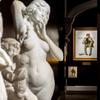The Rebirth of Renaissance Art
- May 31, 2011 09:42
As redundant as it sounds, interest in Renaissance art really is in the midst of a tremendous rebirth. Evolving discoveries coupled with the strong sales performance within the past few years has led to a resurgence in and renewed appreciation for collecting these centuries-old masterworks.
To give you an idea of what I mean, Sotheby's has held six sales that comprised mainly of works by the "Old Masters" which brought in over $117 million in sales...and that's only since January! Within the past few weeks, several important Renaissance works have made headlines in the art world, including a long-forgotten 14th century fresco of Jesus' crucifixion in the Church of St. Anne in Italy's island of Capri reported just days ago.
With the art world abuzz with everything Renaissance lately, it's no wonder there is such a renewed appreciation for these magnificent creations. But it's not as if there is a 600-year-old painting around every corner. What makes collecting Renaissance art truly an art is the limited number of works that even exist, and the even smaller number of those that actually become available on the market to collect-many of which have been ravaged by the passage of time.
That's why we are so excited to have several museum-quality Renaissance paintings currently highlighting our art collection here at M.S. Rau Antiques. These works of art illustrate the dynamic range of techniques and tastes that dominated this, arguably, the most important era of art history. These Renaissance paintings attributed to Bartolomeo di Giovanni depict the Virgin Mary, Mary Magdeline and St. John witnessing the crucifixion of Jesus. Active for only a 21-year period between 1480 and his death in 1501, the artist demonstrates a tremendous gift for expressing the depth and richness of detailing that dominated Renaissance art.
The world of Renaissance art was once the exclusive territory of academia, with art historians decoding the works of barely-known artists you could only read about in scholastic journals. Finally, this stratum of collecting is trickling into the mainstream, exposing the world to the unquestionable brilliance of these forgotten masterpieces.





















